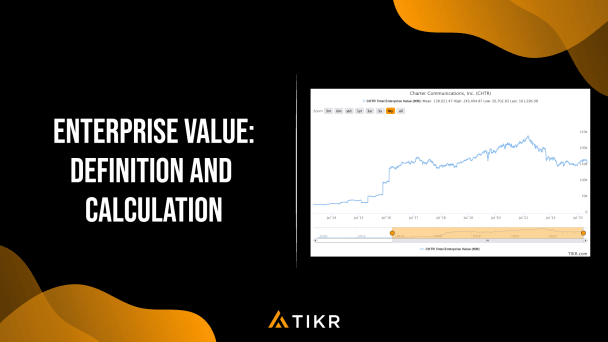Before investing in a company, investors want to be sure that their hard-earned money will generate returns. But figuring this out can be difficult. That’s why investors look at various metrics to evaluate a company’s financial performance. If you’re curious about how companies make the most out of their money and generate profits, then understanding Return on Invested Capital (ROIC) is vital.
ROIC is a powerful metric that helps you see how efficiently a business uses its invested funds to generate profits. So, let’s dive in and discover how to measure ROIC, the relationship between ROIC and WACC, what it tells you, and its limitations. By the end of this article, you’ll also know what a good Return on Invested Capital is.
What Is Return on Invested Capital (ROIC)?
Return on invested capital (ROIC) is a metric investors use to determine how efficiently a company allocates its capital to generate profits. A high ROIC shows the company is investing its capital in profitable projects.
ROIC is often expressed as a percentage. For instance, a 50% ROIC tells you that for every dollar invested in a company, it would generate 50 cents in income. Some investors go for companies with a consistently high ROIC, as it’s a good sign of business performance.
However, savvy investors compare ROIC to the weighted average cost of capital (WACC) to determine if a company uses its capital effectively.
ROIC vs WACC
ROIC measures how efficiently a company generates profits from the capital invested in its operations. It is a key indicator of a company’s ability to generate returns for its shareholders.
On the other hand, Weighted Average Cost of Capital (WACC) represents the average cost of financing a company’s operations through debt and equity. It considers the cost of both debt and equity capital and is used to discount future cash flows in valuation models.
For a company to create value for its shareholders and be financially healthy, its ROIC should be higher than its WACC. If ROIC is greater than WACC, the company earns more from its investments than it pays in financing costs to fund those investments. This means it’s generating excess returns for its investors and shareholders, which is positive for the company’s value. Conversely, if ROIC is lower than WACC, the company’s investments are not generating enough returns to cover the cost of capital, indicating a potential loss of value and financial inefficiency.
How To Calculate ROIC
To calculate ROIC, divide Net Operating Profit After Taxes (NOPAT) by invested capital. It’s usually expressed as a percentage.

- NOPAT: measures the company’s earnings assuming it has no debt. So, whether a company is financed with all equity or has debt, NOPAT is calculated to be the same. To calculate NOPAT, subtract cash taxes from Operating Income or Earnings Before Interest and Taxes (EBIT)
- Invested Capital: Refers to the total amount of capital invested in a company, both from debt and equity sources. It’s the sum of long-term debt, short-term debt, and equity
Pro tip: TIKR.com offers detailed financial data including ratios like Return on Invested Capital on 100,000+ stocks globally.
What Is a Good Return on Invested Capital Ratio?
One useful benchmark is that a good return on invested capital generally exceeds the company’s WACC by at least 2%. A higher ROIC than WACC is a positive sign, showing the company is using its money wisely and creating value for its investors.
Generally, the higher the ROIC, the better, as it indicates the company is more efficient at making money from its resources. For example, O’Reilly Automative (ORLY) has a ROIC of 52% versus its peer Advance Auto Parts (AAP) has a ROIC of 11%. It’s important to understand the drivers of the ROIC difference here but, all else equal, this shows that ORLY may be the better and more efficient business.
Limitations of ROIC
ROIC is a valuable financial metric, but it has certain limitations that should be taken into account.
One-time items can distort ROIC. For example, NOPAT in the numerator can be distorted by restructuring charges, write-offs, litigation, and other one-time charges. It’s important that the inputs to ROIC are a reliable measure of the business’s ongoing operations.
ROIC is also less applicable in some sectors than others. For example, using ROIC to evaluate banks isn’t viable because banks use financing for their products (e.g. loans). In this case, Return on Equity (ROE) would be a better metric to evaluate banks.
Finally, young companies may be unprofitable because they are reinvesting profits back into the business to grow. ROIC would appear negative and therefore as not helpful this early in the company’s lifecycle.
Summary
ROIC tells you how well a company uses its money to generate profits. A high ROIC shows that the company is making good use of its resources by investing in profitable projects and investments. On the other hand, a low ROIC shows that the company might not be using its money wisely and may be struggling to generate sufficient returns on its investments.
However, for ROIC to be useful, investors should compare it to a company’s cost of capital to determine if it is creating value. If ROIC exceeds a company’s WACC, the business creates value for its shareholders. Generally, a company is considered a value creator if ROIC is at least 2% higher than the cost of capital.
Calculating ROIC for thousands of companies can be tedious, but fortunately TIKR.com automates this process for you. Whether you’re examining ROIC or any other financial metric, TIKR has you covered with detailed Income Statement, Balance Sheet, Cash Flow Statement, Ratios and more. With detailed coverage of 100,000+ stocks, there’s no better place to start your investment research. Analyze stocks quicker with TIKR!






